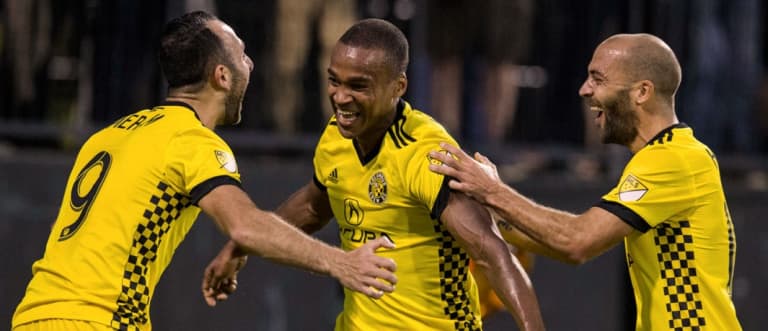Bastian Schweinsteiger danced along the end line like Hemingway working his pen across a moleskin notebook page in a Parisian café.
It was late in the day, the Chicago Fire nursing a 1-0 lead over D.C. United as the match dove deeper into extra time. The Fire merely needed to bleed the clock, and D.C. knew it. And so when Taylor Kemp and Lloyd Sam cornered Schweinsteiger along the end line, they expected him to keep ducking toward the corner flag. The wily veteran didn’t follow convention, instead dipping back toward goal and shucking both before also beating Jose Ortiz for a pinpoint cross into the box.
Nemanja Nikolic couldn’t deposit the chance into the net, but the bell chimed soon thereafter anyway. Another three points for the almost incomprehensibly surging Fire. Or at least compared to where they were a scant year ago, anyway.
MLS is a whipsaw league, where teams are capable of reversing course on a dime. These three have made the most headway from last year en route to significantly better seasons in 2017.
3. Columbus Crew SC

At this point in 2016: 3-5-5
Where they are now: 6-6-1
Why they’re better
Crew SC experienced a bitter, uncontrollably strange 2016 season. After Gregg Berhalter’s pressing, possession style reoriented Central Ohio toward arguably MLS’s most consistently watchable system in 2015, Columbus cratered in 2016. They couldn’t finish in key spots, gave up one of the league’s highest late-game goal rates in recent memory, and they were a rambling wreck on the road. They finished the year just five points out of the Eastern Conference cellar and came nowhere close to the playoffs.
At least through the first third of the season, gravity has largely stabilized in Columbus.
Part of the reason is the simple reality of road form. Columbus finished 2016 a dismal 2-11-4 away from MAPFRE Stadium. Crew SC already have that win total matched, with road wins in Montreal and D.C. with most of the year left to play. The club has 11 more chances to win more road games than it did all of last year. Road form is often the slim decider in a playoff system that rides the rails between in and out, so Columbus are already working ahead of last year’s form.
Aside from the raw standings, there’s actually very little to separate 2016 Columbus and 2017 Columbus so far in a statistical sense. Berhalter’s men are still stacking short passes like a derelict pancake chef (420 in 2016 compared to 434 through last weekend), still putting up quality shots on target numbers (No. 6 in 2016 vs. No. 4 so far in 2017) and still not doing much outright tackling on the defensive end (No. 19 of 20 in 2016 vs. No. 22 of 22 at the moment).
But sometimes the simple answer’s the best one. Crew SC have simply converted more of the same chances they were getting in 2016 and not converting. Go figure. Columbus certainly aren’t complaining.
2. Houston Dynamo

At this point in 2016: 3-7-2
Where they are now: 6-5-1
Why they’re better
At this very point last year, the final featherweight straw floated down off another demoralizing Dynamo result and broke the Owen Coyle era. After a less-than-ideal 2015 season, Coyle lasted 12 games into 2016 with just three wins behind him before parting ways with the Dynamo. Whether due to a desire to be closer to home, a lack of results or a bit of both, the Coyle era left Houston in a precarious middle distance.
Tell Dynamo fans a year ago this moment that in 365 days they’d have an idealistic coach pushing a recognizable style fronting triple the wins from a year ago at this point? Joy doesn’t begin to cover it.
The Orange were mostly poor in 2016 because they had no recognizable style. They were 19th of 20 teams in possession share, which would indicate a desire to either press numbers on the ground hard and fast or bypass the midfield entirely with looping long balls in behind defenders. Lacking width and speed and a singular creative force in the final third, the Dynamo somehow did neither with any regularity. They managed to be 17th in the league in both long balls per game and short passes. They were also tied for 17th in set-piece goals and in on-target shots per game.
Coyle’s successor Wilmer Cabrera has so far flipped that on its head. The Dynamo are suddenly recognizable beyond belief. They do very little substantive defending – their 20 goals are the most allowed by any team currently in a playoff position – but they’ve also scored as many as anyone in the league through a brutishly beautiful style that goes straight at the jugular.
Houston pour a manic 5.3 shots on target per game at opposing keepers, second in the league only to New York City FC. Dams burst at that frequency level. Meanwhile, only three teams in the league have attempted fewer raw passes this year, meaning the Dynamo basically rip straight at you with twin engines Alberth Elis and Romell Quioto off the wings.
With the (somewhat predictable) resurgence of Erick Torres and Cabrera’s willingness to experiment (DaMarcus Beasley at left wing on Saturday? Why not?) these truly are wildly enjoyable days in Houston.
1. Chicago Fire

At this point in 2016: 2-5-5
Where they are now: 6-3-3
Why they’re better
I could probably stop at “Bastian Schweinsteiger” here and call it a day, right? But I have an editor jabbing me in the ribs, so in the interest of fairness I suppose we go deeper.
Schweinsteiger is the obvious answer, of course. He’s chipped in two goals and two assists inside his first nine MLS games, and he should’ve had his third assist on Sunday if not for that glaring miss rifled over the crossbar he so lovingly set up.
The Fire rarely wriggled into dangerous enough positions to snap off meaningful shots in 2016, and they finished second-to-last in shots per game and dead last in shots on target. This year, the Men in Red are up to ninth in the latter category, and Schweinsteiger’s average of 0.3 shots on goal per game by himself helped nudge them in the right direction.
But it’s more than Schweinsteiger. In 2016 Chicago had no player consistently capable of cranking down the verve dial when a game got too hot, which is where Dax McCarty’s been undeniably critical. He’s basically an easily adjustable in-match thermostat. McCarty’s picked up where he left off in New York, and his 67.8 passes per game is sixth in the league. Of note: Schweinsteiger’s 67.4 is seventh, and no midfield combo in the league can come close to matching a combined 135.2 passes per game (at an almost identical 84 percent clip).
Then there’s Nikolic, that other recent Fire signing who’s maybe been the league’s best striker this year. Schweinsteiger’s tactical malleability wouldn’t mean all that much without some help up top for David Accam, and Nikolic’s 10 goals in his first 12 games more or less proved the theory that his signing was perhaps more prescient than anyone’s.
Whether the Fire keep up this pace or not, it’s clear they’re a changed team down to molecular level. Credit where it’s due for seeing far beyond most of us.














